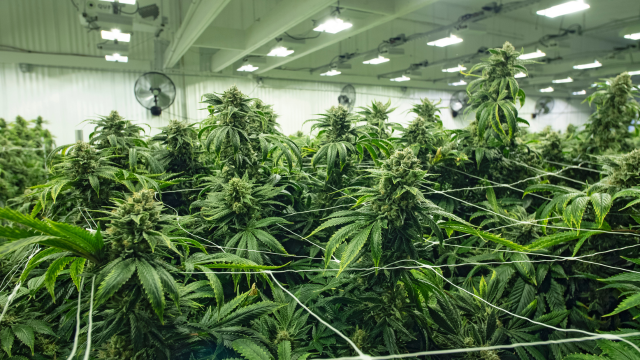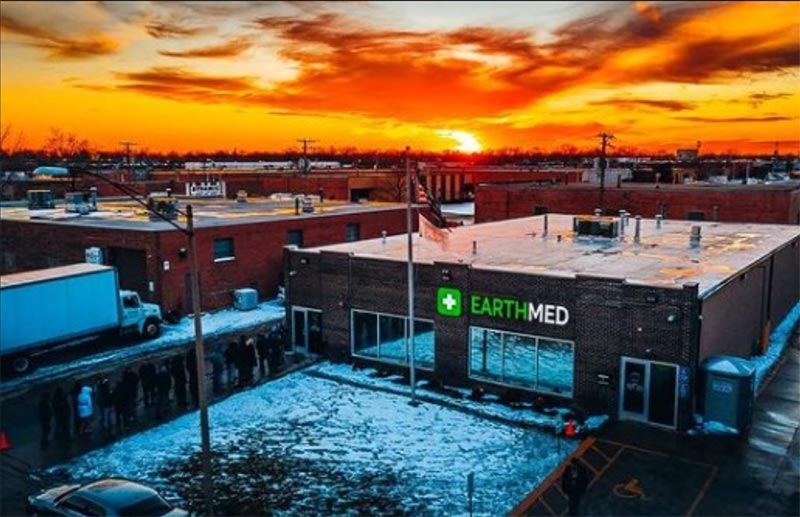Are you at least 21 years of age or hold a valid medical marijuana card?
Daily Specials
{{ special.title }}
{{ special.description }}
*{{ note }}EARTHMED BLOG

The Cannabis Harvest: Trimming, Drying, and Tips

When to Harvest Cannabis
Knowing when to harvest your cannabis plants is crucial for achieving the desired potency, flavor, and overall quality of your buds. Harvesting too early can result in underdeveloped buds with lower THC levels while waiting too long can lead to a decrease in potency and an increase in the degradation of cannabinoids. Here are some key indicators to help you determine when your cannabis plants are ready for harvest:
Trichome Maturity - Use a magnifying tool to inspect the trichomes closely. When they are mostly cloudy with a few amber-colored ones, it's usually a sign that the plant is at peak potency and ready for harvest.
Pistil Color - During the flowering stage, pistils (the hair-like structures on the buds) are white and gradually change color as the plant matures. When most of the pistils have turned amber or brown, it's a sign that the plant is reaching the end of its flowering cycle and nearing harvest time.
Flowering Time - Most strains have an estimated flowering period, typically ranging from 6 to 12 weeks. Find out the estimated harvest time for your strain.
Bud Density and Size - Fully mature buds tend to be dense, firm, and swollen with resin. If the buds feel airy or loose, they may need more time to develop.
Aroma and Flavor - Fully matured buds often emit strong, distinct aromas and flavors characteristic of the strain.
How Long to Let Buds Grow
Determining the optimal length of time to let your cannabis buds grow depends on various factors, including the strain, growing conditions, and desired effects. The longer you allow your cannabis buds to mature on the plant, the higher their potency may become. Additionally, extended maturation can enhance the flavor profile of the buds, as terpenes develop and intensify over time. Consider your preferences for potency and flavor when deciding how long to let your buds grow. Once you feel your buds are ready, its time for the harvesting!
How to Harvest Marijuana
Harvesting marijuana involves several steps to ensure that you harvest your buds at their peak potency and preserve their quality. Here's a quick step-by-step guide on how to harvest marijuana:
Step 1: Prepare Your Tools
Before you begin harvesting, gather all the necessary tools and supplies, including sharp pruning shears or scissors, gloves, and containers for storing the harvested buds.
Step 2: Choose the Right Time
Refer to the indicators mentioned earlier to determine the optimal time for harvesting your marijuana plants.
Step 3: Cut the Plants
Using sharp pruning shears or scissors, carefully cut the branches of the marijuana plants. Start with the lower branches and work your way up to the top.
Step 4: Trim the Buds
Once you've removed the branches, trim the buds to remove excess leaves and stems. This process, known as trimming, helps improve the appearance and quality of the buds.
Step 5: Dry and Cure the Buds
After trimming, hang the buds upside down in a cool, dark, and well-ventilated area to dry. Once dried, cure the buds by storing them in airtight containers, opening them periodically to allow for proper air circulation.
How to Trim Marijuana Plants
Trimming marijuana plants is an essential step in the harvesting process that involves removing excess leaves and stems from the buds to improve their appearance and quality. Here's how to trim marijuana plants effectively:
Gather Your Supplies - Before you begin trimming, gather all the necessary supplies, including sharp trimming scissors or shears, gloves, and containers for collecting trimmings.
Prepare the Work Area - Set up a clean and organized work area with ample space to trim the plants comfortably. Consider using a dedicated trimming tray or table to catch trimmings and maintain cleanliness.
Trim the Buds - Hold each branch of the marijuana plant firmly and use sharp scissors or shears to trim away excess leaves and stems surrounding the buds. Focus on removing large fan leaves and any foliage that does not contain significant trichome coverage. Take your time to trim each bud meticulously, ensuring a clean and uniform appearance. Avoid cutting into the buds themselves, as this can damage their structure and potency.
Collect Trimmings - As you trim the plants, collect the trimmings in a container for later use. Trimmed leaves and small stems can be saved for making concentrates, edibles, or infused products.
How Long Do You Hang Weed Plants After Harvest
After harvesting your weed plants, properly drying and curing the buds is essential for preserving their potency, flavor, and aroma.
Hang your weed plants upside down in a cool, dark, and well-ventilated area to dry. The drying process typically takes about 7 to 14 days, depending on environmental conditions such as humidity and airflow. Monitor the buds closely during this time and adjust as needed to ensure proper drying without mold or mildew development.
Once the buds are sufficiently dried, transfer them to airtight containers for curing. Curing is a process that involves storing the buds in sealed containers and periodically opening them to release excess moisture. Curing enhances the flavor, aroma, and smoothness of the buds and can take anywhere from 2 to 8 weeks or longer.
What Can You Do with Cannabis Leaves
While most of the focus in cannabis cultivation is on the buds, the leaves of the plant also have valuable uses. Those trimmings are still useful for all sorts of applications. Cannabis leaves contain cannabinoids such as THC and CBD, albeit in lower concentrations than the buds. You can use trimmed leaves to make cannabis-infused edibles, such as butter, oils, or tinctures. These infused products can be used to create a variety of culinary delights, including baked goods, candies, and beverages.
Trimmed cannabis leaves can also be used to make extracts, such as hashish, kief, or cannabis concentrates. Extraction methods involve using solvents or mechanical means to separate the cannabinoids and terpenes from the plant material, resulting in potent extracts that can be consumed in various ways.
Some people use cannabis leaves for topical applications, such as making homemade salves, lotions, or balms. While cannabis leaves may not contain as high concentrations of cannabinoids as the buds, they still contain beneficial compounds that can be absorbed through the skin for potential therapeutic effects.
If you're not interested in consuming or processing cannabis leaves, you can compost them to enrich your garden soil. Cannabis leaves are rich in nutrients and can contribute to the health and fertility of your compost pile. Ensure that the leaves are properly decomposed before using the compost in your garden.
Overall, cannabis leaves have a variety of uses beyond just being discarded. Whether you're interested in culinary experimentation, DIY skincare, or soil enrichment, cannabis leaves can be a valuable resource in your cannabis cultivation journey.
By following best harvesting practices and paying attention to key indicators such as trichome maturity and bud density, growers can produce more quality buds. Whether you're a novice cultivator or an experienced enthusiast, exploring different techniques and experimenting with various strains can enhance your cannabis cultivation experience. Remember to research and adhere to local laws and regulations, and as always, stay safe!
{{ locations[0].name }}
{{ locations[0].address }}{{ locations[0].city }}, {{ locations[0].state }} {{ locations[0].zip }}
{{ locations[0].phone }}
Hours
Sun: {{ locations[0].hours_recreational.Sunday }}Mon: {{ locations[0].hours_recreational.Monday }}
Tue: {{ locations[0].hours_recreational.Tuesday }}
Wed: {{ locations[0].hours_recreational.Wednesday }}
Thu: {{ locations[0].hours_recreational.Thursday }}
Fri: {{ locations[0].hours_recreational.Friday }}
Sat: {{ locations[0].hours_recreational.Saturday }}
{{ locations[1].name }}
{{ locations[1].address }}{{ locations[1].city }}, {{ locations[1].state }} {{ locations[1].zip }}
{{ locations[1].phone }}
Hours
Sun: {{ locations[1].hours_recreational.Sunday }}Mon: {{ locations[1].hours_recreational.Monday }}
Tue: {{ locations[1].hours_recreational.Tuesday }}
Wed: {{ locations[1].hours_recreational.Wednesday }}
Thu: {{ locations[1].hours_recreational.Thursday }}
Fri: {{ locations[1].hours_recreational.Friday }}
Sat: {{ locations[1].hours_recreational.Saturday }}






